Today I wanted to share some basic and useful information on acrylic paint brushes – everything you need to know about the different types of brushes for acrylic painting, as well as share some examples of why and how you might use each brush.
When I first started painting with acrylics, I really didn’t know a whole lot about the different types of brushes you could – or even should – use when painting.
I pretty much stopped at my craft local store, grabbed a set of brushes off the shelf and just started painting with the one I liked best.
To be honest, it was over a year of painting regularly before it even dawned on me that maybe the different brushes could be used for different effects and techniques!
Fortunately, I’ve learned a LOT since I first started acrylic painting, and so today I wanted to share some information on the most common types of paint brushes when working with acrylics and what each brush might be used for. 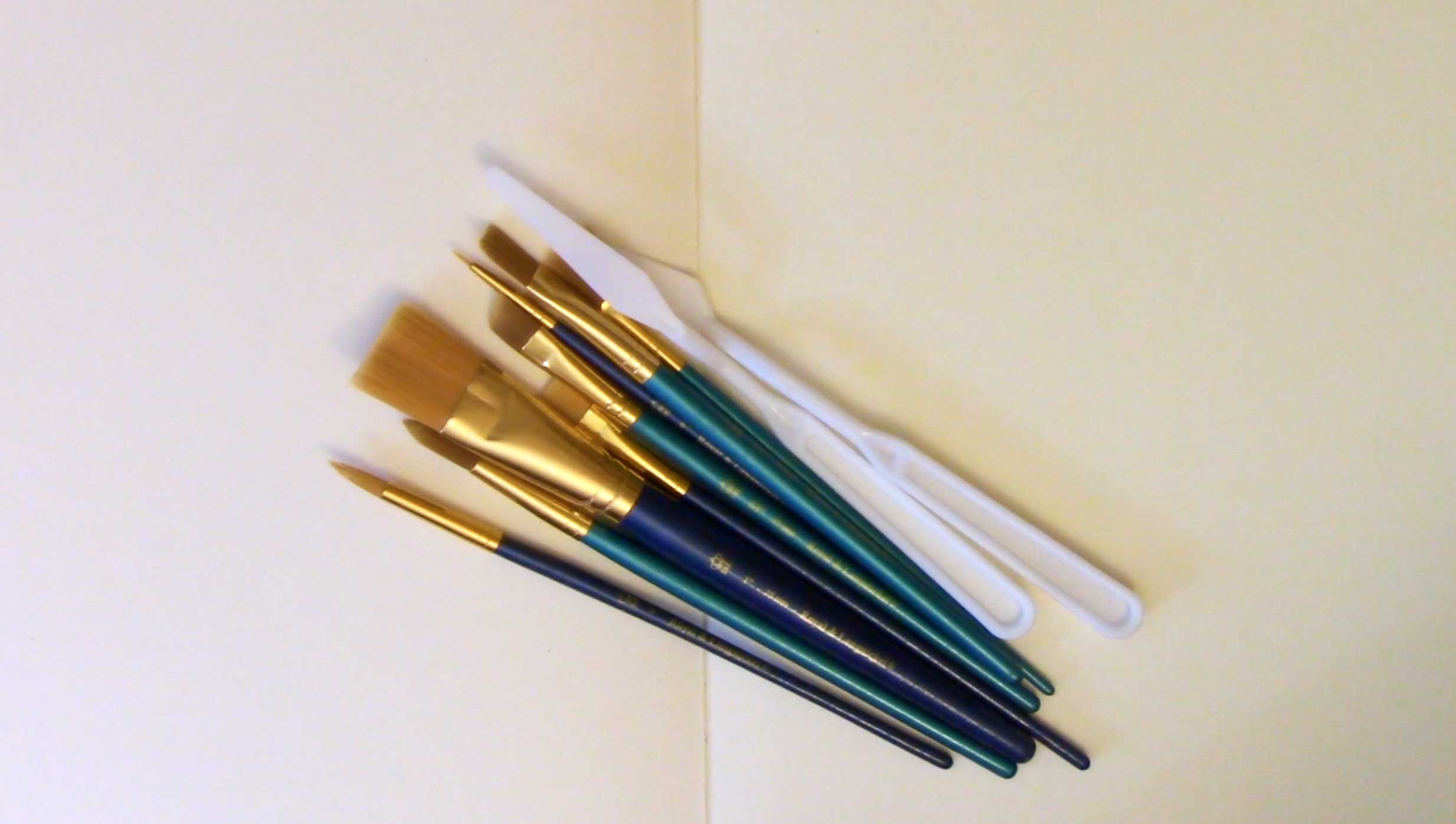
Rule #1: Know The Acrylic Painting “Rules” So You Can Break Them!
While of course there is no set of definite rules on which brushes you can or should use – as the saying goes it does help to know what the rules are so you can break them effectively!
Often times I find myself using the same basic acrylic brush types over and over again – not because I’m not aware of which brushes should be used – simply because I use the brushes that feel right and make me want to create the most!
Other times I find that it is very helpful to push beyond using just one or two brushes. Using the different types can give you different results – and help you grow as a creative artist.
Pablo Picasso is just one example of an artist who had a very good understanding of this concept!

Learn the Rules Like a Pro, So You Can Break Them Like an Artist. Pablo Picasso
It’s true: most of these brushes can be used in many different ways and for different techniques. Some artists may even disagree with the suggested uses for the different brushes!
While some brushes are more common for different methods, there is certainly no wrong brush. It’s up to you the artist to decide which ones you are most comfortable working with!
If you find yourself wanting to use a brush in a different manner than I share here – do not worry! There is nothing wrong with you or your style of art – much of it is part of your own personal preference.
The goal here is to not make you a classically trained artist – I know I certainly am not one! My hope is to simply share with you some of the tools that can make your life a LOT easier for achieving different effects that you may be wanting to try in your own art.
It’s always better to work with the paint brush than fight it!
By understanding the different types of acrylic paint brushes and what each one can be used to achieve in your artwork – it opens up your creativity to stretch your imagination and explore with new different acrylic painting techniques.
The 7 Most Common Types of Acrylic Paint Brushes
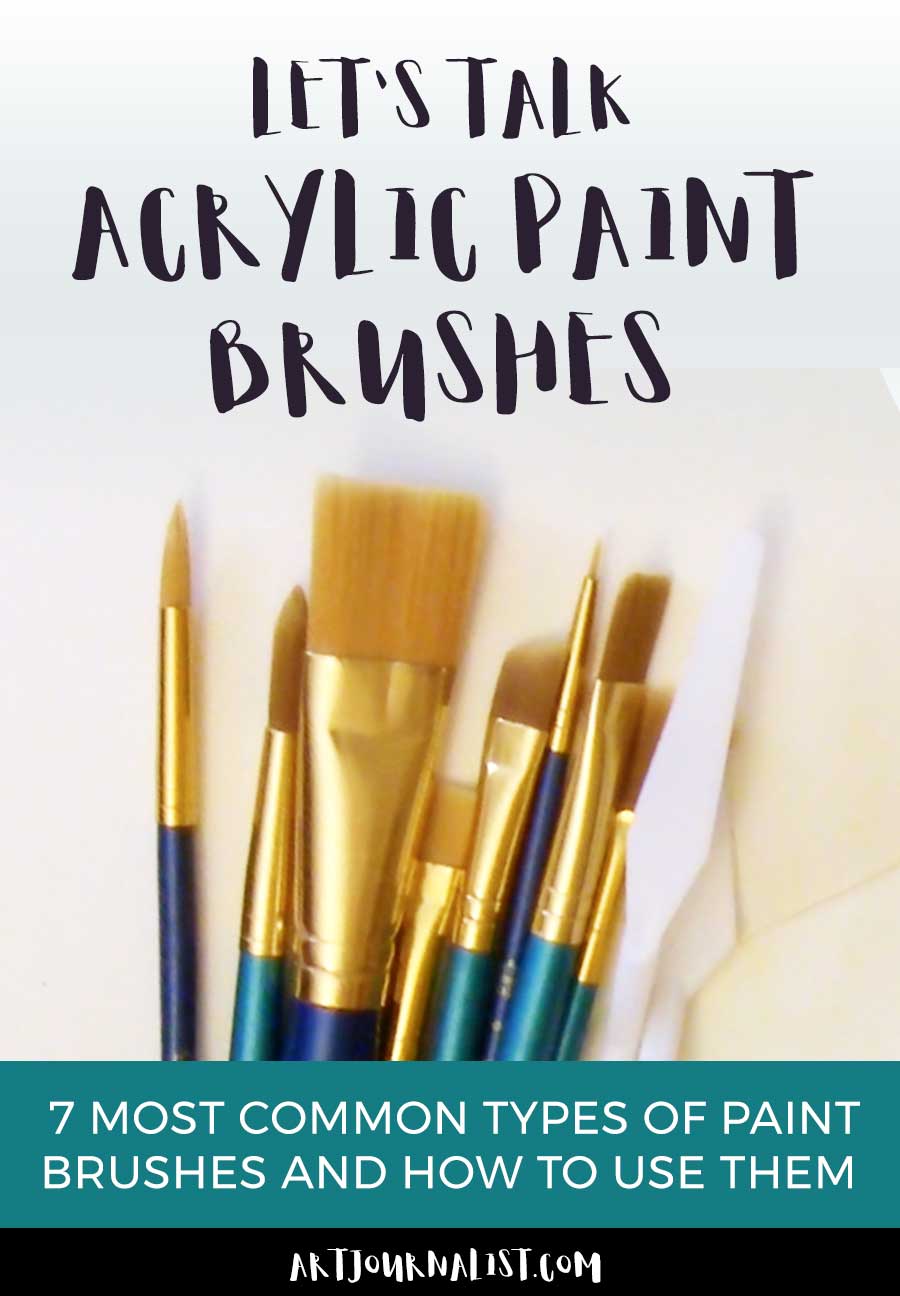
This list includes the 7 most types of acrylic paint brushes and what they are most commonly used for. Keep in mind though that these are just general recommendations and suggestions.
While some fine artists might be uptight about knowing what are the right brushes to use for different acrylic painting techniques – remember there is no such thing as the art police!
Your art is supposed to be fun and creative – and pushing the limits and the way things are normally done is exactly what makes most artists the amazing talented creative people they are!
#1: Acrylic Wash Brush
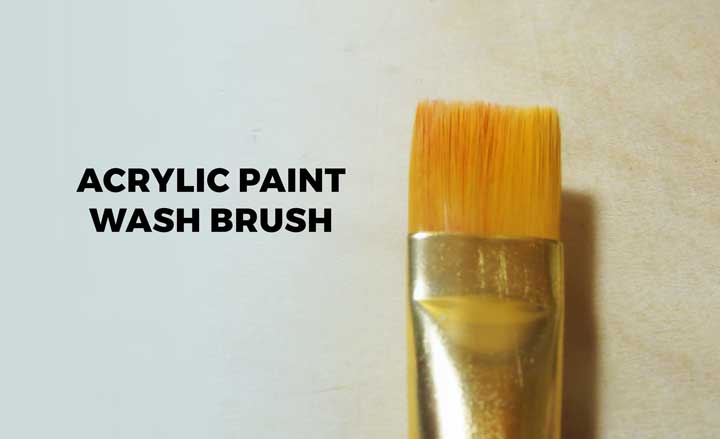
The acrylic wash brush is a paint brush that is VERY big. If you purchase a set of paint brushes and notice a brush that is gigantic compared to the rest – it is most likely a wash brush!
Acrylic wash brushes are best known for covering large parts of canvas or paper quickly. Paint can be applied using a dry brush, but most artists will use a wash brush by first dipping it into some water to achieve maximum coverage quickly.
You may also notice these brushes are also thicker than most other brushes – allowing for the brush to pick up the most amount of paint and water. These are great brushes to use if you need to “pick up” a little excess paint or water off the canvas or paper you are working on.
#2: Angled Brush

The angled acrylic paint brush is one of my go-to paint brushes. I use this brush almost more than any other brush when creating mixed media art journal pages!
This type of painting brush has an angled or slanted tip, which is why they are sometimes also known as slanted brushes.
A slanted tip for the bristles is especially useful for curves and being able to create lines and shapes that vary in thickness and coverage. If you like the flexibility of being able to go from thin to thick with just one brush, this is the brush for you!
Angled paint brushes can also be more comfortable for many artists who are painting on a canvas upright on an easel, as there is sometimes a learning curve there since most of us learn to draw and paint while sitting down at a table at first!
#3: Flat Brush

The flat brush very closely resembles a wash brush, except it is not quite as thick and the bristles are typically not as rounded on the edges.
Flat brushes are great for wide strokes where you want a lot of paint coverage. If you are working on a surface where a wash brush might be too large, the flat brush gives you excellent coverage while also providing you a little more control over the wash brush.
Flat brushes can also be used for thick to thin lines, however for many people the angled type will likely provide a little more comfort and control when working on a canvas at an easel.
#4: Fan Brush
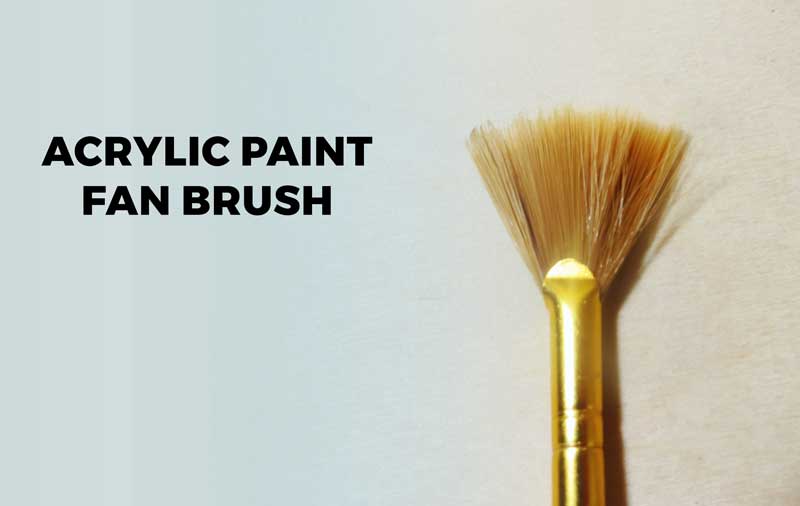
The fan brush will become your new best friend if you’ve ever tried painting trees, grasses, shrubbery, or even abstract watery types of designs with acrylic paints.
Fan brushes, as the name would imply, have a fan shaped tip. These brushes are great for blending backgrounds and skies, as well as adding subtle highlights to darker areas.
You can also play around with a lot of different textures using a fan brush. If you tap the brush, you will get a different effect than if you simply create long brush strokes with it.
While we often associate these brushes for painting nature elements and landscapes in acrylics, these brushes can also be excellent for adding fun textures and different designs in your mixed media art journals and abstract paintings as well!
#5: Round Brushes

Round brushes are typically much smaller than flat and angled brushes, and have a soft rounded edge.
These brushes give you maximum control for different details in your acrylic painting. The handle of these brushes have a narrower design and so are similar to the same feeling you would have when holding a pen or pencil.
Use these brushes for adding details and when you need full control of the size and flow of the paint. You may also wish to experiment with using these brushes both wet and dry for different effects while creating.
#6: Liner Brush
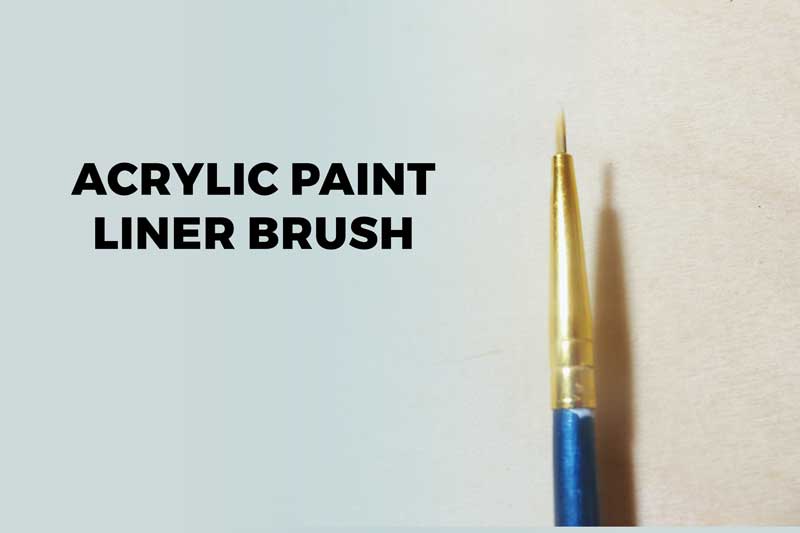
A liner brush is a very thin brush with very long bristles. It somewhat resembled the round brush, except it is MUCH, MUCH, MUCH smaller!
Liner brushes are best used for fine details in your artwork. You can use liner brushes to dip into acrylic paint or even with ink. Liner brushes are excellent for having a lot of control of the paint brush and for creating very thin lines.
You can also use a liner brush for lettering and adding words to your pages. Because the brush tip is very small, this makes it easier to write out letters, numbers and words. Many artists who sign their artwork would use a liner brush when writing their signature. In art journaling, this is a great way to add text and words to your pages.
Liner brushes work best when wet, although they can of course can also be used dry. Dipping into water before the paint can help make the paint flow and spread a bit more smoothly. You can also use ink with liner brushes, which makes it very economical compared to using pens.
#7: Palette Knives

Palette knives are technically not actually brushes at all, but they are a very common and popular way to apply paint to canvas. Many artists use palette knives in a variety of different ways to create different textures and effects in their artwork.
The palette knife shown here and in the video at the end of this article are made from plastic. Plastic knives will work well for beginners and for your first experiences in exploring acrylic paints, but if you really love using them, it would be wise to invest in a metal palette knife.
The advantage to a metal palette knife is they are generally much easier to clean. Metal palette knives are also much less likely to snap and break if too much force is accidentally applied to them.
You can use palette knives to create different textures, spread paint, and build up various layers. Palette knives are most popular to use on canvas, because the paint tends to be applied very thickly.
You can certainly use a palette knife in your art journals – just be sure that you allow for ample drying time to ensure pages do not stick together! You may also wish to use a lesser amount of paint so that the drying time is not as long.
Want to See These Acrylic Paint Brushes in Action? Watch the Video!
Our video on our YouTube channel goes over the many different acrylic paint brushes and shares some examples of them in use. You’ll see each of the 7 most common brushes listed above as I share what they do both dry and wet.
{Wet means dipping the brush into water first, dry means without water!}
You can also watch the video on YouTube here: Acrylic Paint Brushes 101
This video I made will walk you through each brush step by step as I experiment with the different effects of each one in my art journal. Hopefully the visual video guide will give you some better idea for the many different ways you can start using these brushes in your art journal and moving onto bigger projects such as acrylic painting on canvas as well!
Start Using Your Different Acrylic Paint Brushes!
My challenge for you today? Go try ALL the brushes that come in your brush sets! Create some new fun textures, shapes, and styles in your art journal with them!
What Are Your Thoughts? Have Questions About Using The Different Acrylic Paint Brushes?
Do you have a favorite acrylic paint brush that you use the most? Have you tried any of these techniques before for painting with acrylics?
Or, do you have any questions about how to choose which acrylic paint brushes might work best for the techniques or style of art you want to create?
Share your thoughts & ask away in the comments section below!
Join our facebook group!

Share what you’re creating and working on, ask questions + connect with over 4000 creative artjournalists for inspiration + ideas!
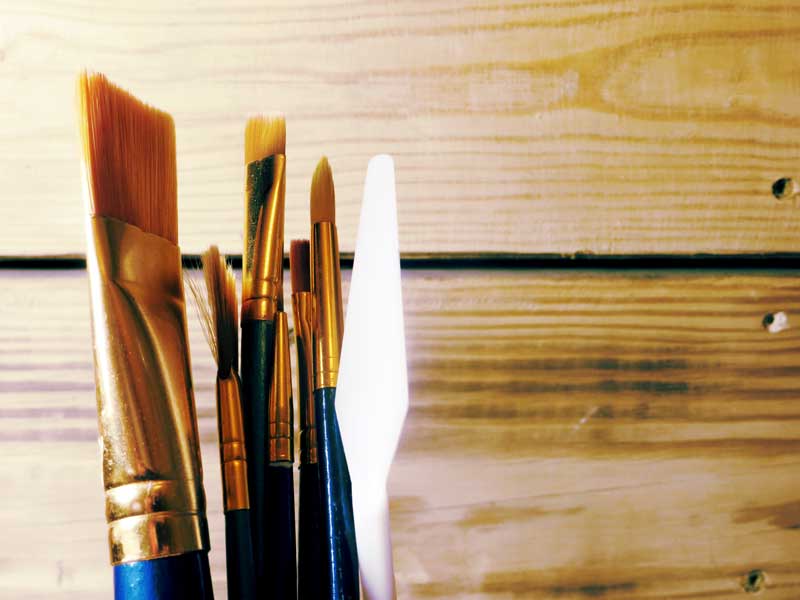
I do have my favorites, trying to make myself use all I have, maybe I’ll learn something along the way. And I have learned the biggest problem I found, is the paint QUALITY is very important, the cheap stuff is horrible. And what I think I will do going forward is start with the cheap to get ideas down then finish with the good stuff.
THANKS, MY BEST,
JOHN ALMOND
Thanks John, I think we all have favorite brushes, but it is fun to push yourself to try to use the others. 🙂 And yes, paint quality can make a big difference, but I think learning with the cheap paints is a great way to not be afraid of it “going to waste” – and then it can help you gain the confidence to really enjoy the professional quality brands.
Thanks for this tip!
Thanks for this article. I really needed it in basic language.
Started to paint in recent times…wish to go a long way.Wish me luck as still learning .
I want to buy 7 brushes. Will you recommend the best brand to buy please for acrylic painting. I want a good brand. Not student quality. Not boar bristle or nylon but synthetic for acrylic. Thank you!
My personal favorites are the Zen collection from Royal and Langnickel. They hold up well, are made for acrylic paint and have metal handle that clean up so easily. Try just one at first to see if you like them.
what kind of brush should I use(buy) to paint back ground for a portrait
painting. I see that background paintings on canvas have mix colors and are
nicely blended. Any suggestion please?
A wash brush would work well for getting a nice even painting background Charles!
i have just started to paint and have just received my first set of acrylic brushes, they are very stiff and hard are they protected with something, do i need to wash them first, everybody talks about cleaning the brush but not about prepping the brush for first use or am I just being silly?
No silly questions when it’s just for art!
I’m also pretty new to painting and read that you should always rinse new brushes in water. I think someone even said a drop of Dawn dish soap with warm water. So I always rinse my new brushes with warm water, form the tips with my fingers, and let them dry standing up. 🙂
I definitely do not use warm water when washing my brushes. I lay
them flat to dry. Standing the brush upright to dry allows any moisture to gather at the base of the bristles and can eventually harm the glue that keeps the bristles intact.
I try to different the brush paint but it’s hard find for fur animals or pet. And I love the brush paints for drawing.
thank you this wonderful article, i’m just a begginer and still trying to understand what the brushes can do to my art work.
Thank you Dennis, glad it is helpful for you!
What a wonderful contribution you make to the many art students and “somewhat art students” as myself .
Thank you for your dedication and providing essential tools and tips. John
Thank you so much!! I am brand new at this and your article helped a lot !!
You are welcome Jill, glad it was helpful!
Thank u so much. I’ve been painting for years and never had a clear understanding of the use of some of the brushes. It all makes sense.
Thank you so much, I’m trying to understand and have all the information since I start this new journey. It would be great if you could point some brands or where I could buy, because my first experience was not that good the brushes were not good and it kind of ruined my paints. This article was really good for me😊😊
Hi Joelma, everyone has different preferences for favorite brushes, and usually the old adage of “you get what you pay for” rings true. Sometimes even well-known brands can have problems. Grumbacher is a brand that many artists consider the “gold standard” but there are many other low cost options available. I often use Artist’s Loft brand or even Loew brand without too many issues.
It was a complete guide for me,I was really confused about brushes. I’m working on phone cases and I draw detailed things like anime,For making sure that the thing that is drawn on the case wouldn’t stick to the phone,should I use any fixer?
Hi Ed, the first thing is to make sure that you can draw/paint on the phone without it easily scratching off – many markers + paints will wear off of Plastic over time. If you were to sand the phone to “scratch it up” a bit with very fine grit sandpaper, and then use multi-surface paints or markers that are specifically meant to stick to plastic, you will minimize the likelihood of it wearing off. Applying a varnish or sealant would be ideal because we use our phones a LOT and so it’s quite likely the artwork will wear off over time if it’s not sealed. Hope that helps!
Hi- I have a question. I do abstract art on large canvases and want to paint really long lines, some curved, by hand – but I’m having a hard time finding out what type of brush I should use. I’ll often mix a pouring medium into the paint to make it carry a long way, but what brush will hold a lot of paint and apply it evenly, without widening, over a large area? Is it a large ‘rigger brush’ with natural hair because they hold more paint? Or a round/flat/or angled ‘watercolor brush’ because they hold even more paint? Please let me know- thank you!
Hi Ron! It will probably take a little bit of experimentation because there are so many factors, like how you hold the brush, how much pressure you apply, etc. that could give different people different results! I would probably start with a round brush because they are going to give you the most control depending on the width of the line but a large angled brush might also do the trick, especially if they are wide lines. Adding some type of medium is a good call – I haven’t tried pouring medium, but I’d probably use something like High Flow medium also – https://www.dickblick.com/products/golden-high-flow-medium/ – that will help make it easier for the paint to spread a long distance without affecting the pigmentation. You could also try using something to use as a mask/outline/stencil/template for the long lines so the paint doesn’t go father than you want it to. Hope that helps and wish I could give more information – do let us know what works for you and of course we’d love to see the art you make so keep us posted on that too! 🙂